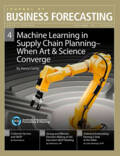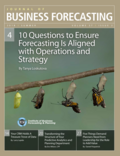 Cart
(0)
Sign In
Cart
(0)
Sign In
- Type of content
- All Knowledge
- Analytics
- Process
- Technology
- People
17
Articles Available
This column is a modified version of an article I wrote, “Sales and Operations Planning (S&OP) Mindsets,” published in the JBF back in April 2007. While the content is largely the same as the one written 12 years ago, it is probably even more relevant today. Back then, S&OP was not as widely used as it is now but many of the challenges of running a well-functioning S&OP process remain the same. The major recommendation here is that one should establish clearly defined roles for various functional managers on an S&OP team—ones that are based on their psychologies or mindsets. I present a framework for understanding different stakeholders’ personalities in the S&OP meeting that can foster collaboration and help in achieving consensus.
Summer 2019
4
All too often, skilled Demand Planners and Forecasters fail to convey the value of their insight to key stakeholders, failing to get buy-in and establishing demand planning as a key business tool. Demand Planners often make the mistake of thinking that the value-proposition of forecasting is self-evident, when in fact it must be clearly explained. Without explaining the “why,” stakeholder buy-in and executive sponsorship will remain elusive. Here I explain how to reframe our own perception of forecasting to change the way others perceive us and our field and, critically, how we must embrace the change management element of our roles if we are to ensure forecasting becomes integrated into our businesses.
Spring 2019
2
If you are looking to take your Demand Planning career to the next level, gaining influence is critical to success. Achieving influence will move you from just having a seat at the table to having a voice at the table. In this article, I will outline six tactics you can use to cultivate this skill. These strategies will combine analytical, communication and relationship building skills.
Spring 2019
4
Recent changes in Big Data and analytics are having a huge impact on the culture and organizational structure of demand planning, forecasting and related roles. Whilst most companies have recognized this, we still need a blueprint of what this new organization may look like and how we get there. This article discusses a new way to optimize the skills and responsibilities of these specialized functions and the steps you need to take based on your organization’s maturity. Additionally, for professionals who work in these fields or who are about to enter, this article discusses the types of career paths that can help maximize abilities and fulfill aspirations.
Summer 2018
It is getting more and more challenging to find the right employee with the right skills. To help, we should adjust what we are looking for and focus on core competency. The terms Skills and Competencies are used, virtually, interchangeably. In fact, with many HR practitioners, competencies seem to only relate to “Behavioral” competencies as defined in a Competency Dictionary. But this really is not the case. If you are hiring in demand planning or any similar field, you need to know what to look for and how to hire the right person. So, in this article we attempt to define the difference between Skills and Competencies, and provide some insight into the different types of core competencies that are critical to demand planning, forecasting, data science, and related fields.
Spring 2018
As forecasters, we continue to look ahead and, to the best of our ability, try to determine what is next. It is only fitting that together we take this view into the next decade, and look at what changes may be on the horizon in our own industry and in the field of forecasting and demand planning. This article, using results from a recent survey of the future of forecasting and demand planning, looks at how people in the field feel about where we are heading, and how we may need to adapt to the next generation of demand planning.
Winter 2017-2018
With Artificial Intelligence, Machine Learning, and Augmented Reality, we cannot help but wonder if the reality is that our roles will be replaced by CPUs. While I do not think we will be replaced by robots in near future, there is an evolution happening today. In this article, we will look at the transformation of the demand planner of today to the data scientist of tomorrow, and how we may be able to start planning for how to be prepared when we get there.
Winter 2017-2018
The business environment is becoming more and more disruptive. New innovative technologies, product and service offerings, and globalization are upending business models in every industry. Business is fast-paced, consumer behaviors are constantly shifting, increased uncertainty and volatility is the order of the day, and the future is no longer a fixed destination. These forces have significant impact on demand forecasting and management. It is therefore imperative that managers responsible for forecasting and managing demand in this highly disruptive environment possess the right skill set to deal with these disruptive forces.
Winter 2017-2018
Every so often, a dialogue will start about the traits that make a good S&OP leader. Some folks will offer specific educational requirements, while others will discuss job experience. Still others will define softer skills such as persuasion and likability, or even effective communication skills. I am not sure there is a specific skill set required, although there are many traits that S&OP leaders have in common.
Summer 2017
Demand Forecasting and Planning is about people, process, and technology. Unfortunately when one reads most articles today, it wouldn’t be evident. This is not to say that in a field of forecasting, there may be a bias, which is understandable, but practitioners just speak about process and software providers about technology. This goes on as little to no attention is paid to one of the most important variables in planning: people.
Spring 2016
6
During the past decade there have been major shifts in demand management. Unfortunately, there has been more discussion than actual adoption; where adoption has occurred, there has been little if any sustainability. A demand-driven process is all about dynamic marketplace choices to drive profitability in existing and emerging segments.
Fall 2015
8
This column discusses a dark period during my five-year tenure of revenue forecasting for a service division of a computer manufacturer. It was a year in which revenues started to take a turn for the worse— going from historic double-digit percentage growth to flat revenue. While the company environment became awkward, unsettling, and politicized, I survived, and even thrived, after it was all over. Some lessons I learned are discussed here; they
might prove useful for today’s business forecasting managers.
Spring 2015
3

















